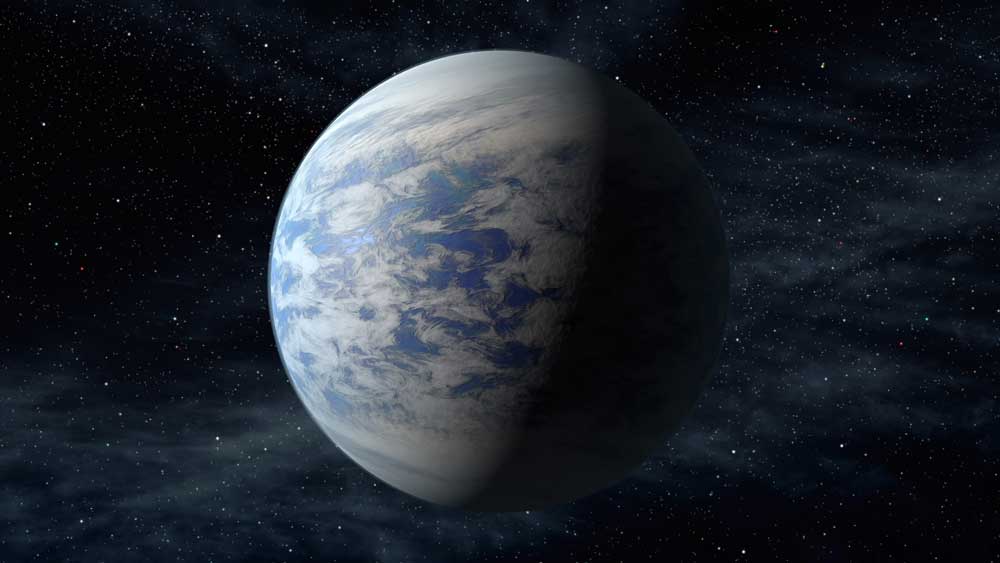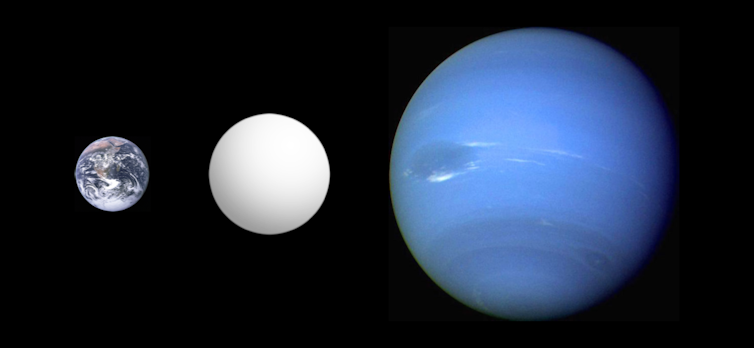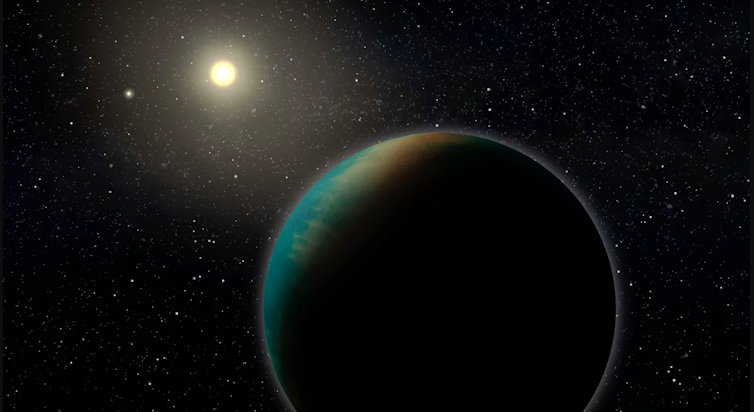
By Chris Impey
Astronomers now routinely discover planets orbiting stars outside of the solar system – they’re called exoplanets. But in summer 2022, teams working on NASA’s Transiting Exoplanet Survey Satellite found a few particularly interesting planets orbiting in the habitable zones of their parent stars.
One planet is 30% larger than Earth and orbits its star in less than three days. The other is 70% larger than the Earth and might host a deep ocean. These two exoplanets are super-Earths – more massive than the Earth but smaller than ice giants like Uranus and Neptune.
I’m a professor of astronomy who studies galactic cores, distant galaxies, astrobiology and exoplanets. I closely follow the search for planets that might host life.
Earth is still the only place in the universe scientists know to be home to life. It would seem logical to focus the search for life on Earth clones – planets with properties close to Earth’s. But research has shown that the best chance astronomers have of finding life on another planet is likely to be on a super-Earth similar to the ones found recently.

Aldaron, CC BY-SA
Common and easy to find
Most super-Earths orbit cool dwarf stars, which are lower in mass and live much longer than the Sun. There are hundreds of cool dwarf stars for every star like the Sun, and scientists have found super-Earths orbiting 40% of cool dwarfs they have looked at. Using that number, astronomers estimate that there are tens of billions of super-Earths in habitable zones where liquid water can exist in the Milky Way alone. Since all life on Earth uses water, water is thought to be critical for habitability.
Based on current projections, about a third of all exoplanets are super-Earths, making them the most common type of exoplanet in the Milky Way. The nearest is only six light-years away from Earth. You might even say that our solar system is unusual since it does not have a planet with a mass between that of Earth and Neptune.

Nikola Smolenski, CC BY-SA
Another reason super-Earths are ideal targets in the search for life is that they’re much easier to detect and study than Earth-sized planets. There are two methods astronomers use to detect exoplanets. One looks for the gravitational effect of a planet on its parent star and the other looks for brief dimming of a star’s light as the planet passes in front of it. Both of these detection methods are easier with a bigger planet.
Super-Earths are super habitable
Over 300 years ago, German philosopher Gottfried Wilhelm Leibniz argued that Earth was the “best of all possible worlds.” Leibniz’s argument was meant to address the question of why evil exists, but modern astrobiologists have explored a similar question by asking what makes a planet hospitable to life. It turns out that Earth is not the best of all possible worlds.
Due to Earth’s tectonic activity and changes in the brightness of the Sun, the climate has veered over time from ocean-boiling hot to planetwide, deep-freeze cold. Earth has been uninhabitable for humans and other larger creatures for most of its 4.5-billion-year history. Simulations suggest the long-term habitability of Earth was not inevitable, but was a matter of chance. Humans are literally lucky to be alive.
Researchers have come up with a list of the attributes that make a planet very conducive to life. Larger planets are more likely to be geologically active, a feature that scientists think would promote biological evolution. So the most habitable planet would have roughly twice the mass of the Earth and be between 20% and 30% larger by volume. It would also have oceans that are shallow enough for light to stimulate life all the way to the seafloor and an average temperature of 77 degrees Fahrenheit (25 degrees Celsius). It would have an atmosphere thicker than the Earth’s that would act as an insulating blanket. Finally, such a planet would orbit a star older than the Sun to give life longer to develop, and it would have a strong magnetic field that protects against cosmic radiation. Scientists think that these attributes combined will make a planet super habitable.
By definition, super-Earths have many of the attributes of a super habitable planet. To date, astronomers have discovered two dozen super-Earth exoplanets that are, if not the best of all possible worlds, theoretically more habitable than Earth.
Recently, there’s been an exciting addition to the inventory of habitable planets. Astronomers have started discovering exoplanets that have been ejected from their star systems, and there could be billions of them roaming the Milky Way. If a super-Earth is ejected from its star system and has a dense atmosphere and watery surface, it could sustain life for tens of billions of years, far longer than life on Earth could persist before the Sun dies.

Benoit Gougeon, Université de Montréal, CC BY-ND
Detecting life on super-Earths
To detect life on distant exoplanets, astronomers will look for biosignatures, byproducts of biology that are detectable in a planet’s atmosphere.
NASA’s James Webb Space Telescope was designed before astronomers had discovered exoplanets, so the telescope is not optimized for exoplanet research. But it is able to do some of this science and is scheduled to target two potentially habitable super-Earths in its first year of operations. Another set of super-Earths with massive oceans discovered in the past few years, as well as the planets discovered this summer, are also compelling targets for James Webb.
But the best chances for finding signs of life in exoplanet atmospheres will come with the next generation of giant, ground-based telescopes: the 39-meter Extremely Large Telescope, the Thirty Meter Telescope and the 24.5-meter Giant Magellan Telescope. These telescopes are all under construction and set to start collecting data by the end of the decade.
Astronomers know that the ingredients for life are out there, but habitable does not mean inhabited. Until researchers find evidence of life elsewhere, it’s possible that life on Earth was a unique accident. While there are many reasons why a habitable world would not have signs of life, if, over the coming years, astronomers look at these super habitable super-Earths and find nothing, humanity may be forced to conclude that the universe is a lonely place.
![]()
Chris Impey is University Distinguished Professor of Astronomy at the University of Arizona.




























Jimbo99 says
Uggghhhh, where to start with this article. Planets 30-70% larger than Earth, taking the equivalent of 3 Earth days to rotate around it’s Sun. I’ll let that sink in for a moment. Planet Earth daylight ranges from 10+ to 14+ hours. The other hours are nightfall obviously. There would be 3X that much continuous “sunlight” on that planet for any given rotation around that Sun. Sleep deprivation studies for Earthlings, imagine getting 30+ to 42+ hours of continuous sunlight. That isn’t an evolution of the human race. This is some egghead with this fantasy of finding this better than Earth solution 6 light years away to save humanity.
What’s even worse about these Super Earths that they hope to find, has to be at least at the maximums of what Earth has. This reads like a bad 1960’s sci-fi sitcom/movie plot, Lost in Space or Star Trek that will take in Earthlings like illegal immigrants sneaking across the border. If mankind is truly fortunate to exist, since these Super Earths already exist, where is all the species of life that Earth actually has ? Somehow earthlings are supposed to be able to travel light years to take their rightful place on these Super Earths to continue to pollute those planets in exactly the same manner that Earth is being overpopulated & polluted. The biggest waste of money & resources ever is the 1st thing that anyone can possibly think of. The other day there was an article written on why NASA should drop the space programs because we have Billionaires that have their own space exploration programs. I can’t watch this show any longer without speaking my mind on it anymore. Maybe our leaders need to have someone tell them a bedtime story. So here we’ll go, off to a planet that is 20-70% larger than Earth to go establish money, war, poverty, famine, disease. Is anyone else paying attention ? And what happens when they find oil on these Super Earths ? Or is that electricity & a grid that needs to be built. FCOL, they can’t even build a grid in Puerto Rico that doesn’t get wiped out every year with the next Hurricane that steamrolls that island.
https://www.npr.org/2022/09/18/1123690268/puerto-rico-hurricane-fiona
I know if I strolled in with this level of stupidity, they would have me in a padded room under observation. All we have to do is look at what the EV transition is costing to realize if it can’t be done for 100’s of billions & trillions in the USA, not to mention any other nation Asia or Europe without the fossil fuels being diverted. Does anyone think Biden-Harris are even remotely interested in saving the Earth or the human race with this ? It’s really time to stop this insanity. Trump-Pence was never this stupid, couldn’t ever approach the level of stupidity the current leadership is going with this. City of Palm Coast can’t even get a bid/offer to taker over the Green Lion location, what hope does the human race have that Biden-Harris is going to discover a planet that is more inhabitable than Earth in the next 2-4 years. Who voted for this ? Certainly needs to have their voter registration permanently revoked. I guess maybe the Biden-Harris plan is to build a space travel Wawa as an intergalactic network of refueling stations.
Michael Cocchiola says
As soon as scientists find a viable super-earth, I’m going there just to get far away from that child-kidnapping DeSantis and his mentor, #45.
DaleL says
Some super earths may be very suitable for life. However, our Earth has a relatively thin atmosphere. A super earth would presumably also have a super abundant (thick) atmosphere. We have an example right next door, so to speak, in Venus. The atmosphere of Venus has 10 times the quantity of nitrogen as that of the Earth. That thick atmosphere and closer proximity to our Sun, has resulted in temperatures at the surface of 800 to 900 degrees F.
Assuming a super earth is far enough from its star so as to have a livable temperature, the dense atmosphere would make it very difficult for any beings to observe stars or other celestial objects. The beings would have to develop advanced technology just to get above most of their atmosphere to observe and discover the nature of the universe.
Our planet’s mass and resulting gravity make it difficult to launch into space. Realistically, it takes two stages just to reach Earth orbit. Beings on a super earth would likely need the equivalent of the Saturn V just to reach orbit.
I am sure that in the vastness of our universe there are other intelligent beings. However, because of how vast the universe is, I doubt we will ever meet them.